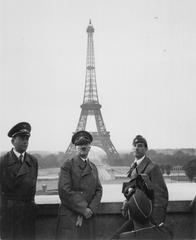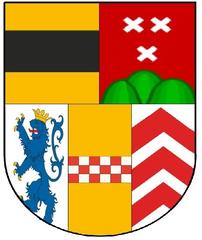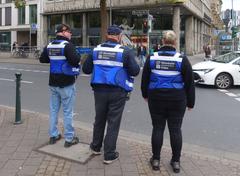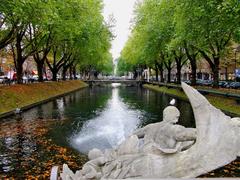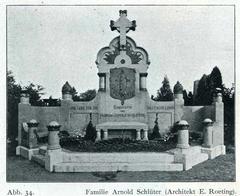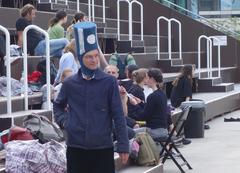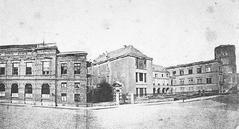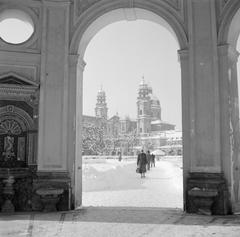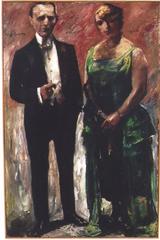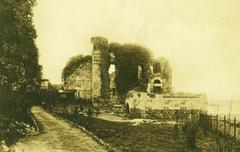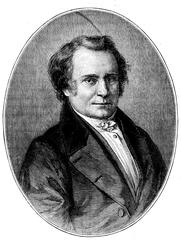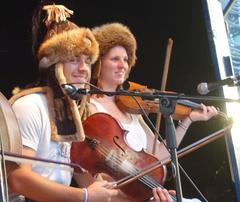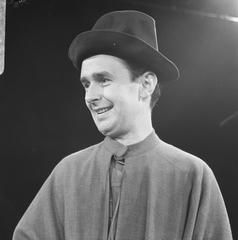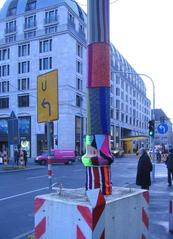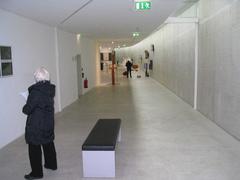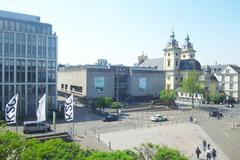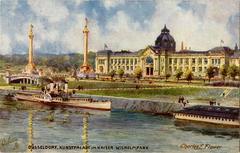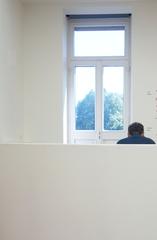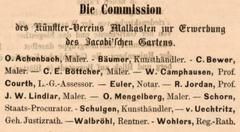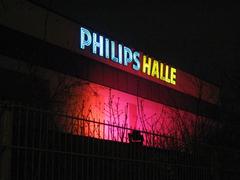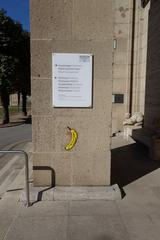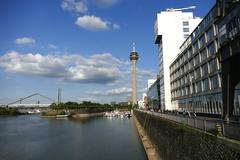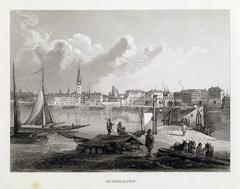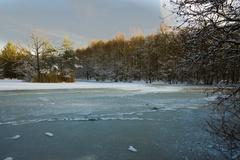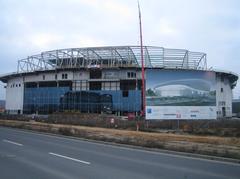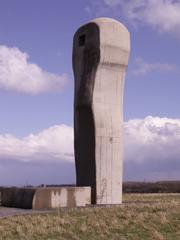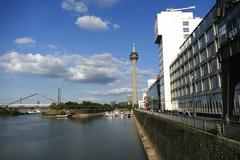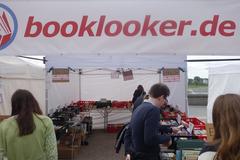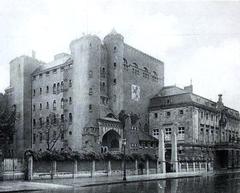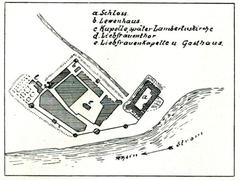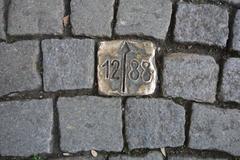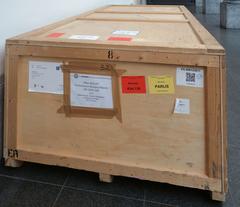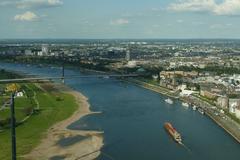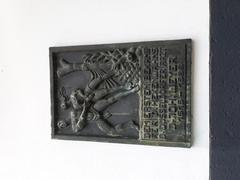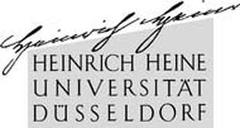Rheinufer Tunnel: Visiting Hours, Tickets, and Historical Significance in Düsseldorf
Date: 04/07/2025
Introduction
Beneath the picturesque banks of the Rhine River, the Rheinufer Tunnel in Düsseldorf stands as a testament to visionary urban planning and engineering innovation. Completed in 1993, this nearly 2-kilometer-long tunnel redirected a major expressway underground, restoring the city’s vital connection to its riverfront and giving rise to the lively Rheinuferpromenade above. Today, the promenade is a beloved public space that seamlessly blends historic charm with modern vibrancy, while the tunnel itself remains a crucial artery for city traffic. This guide explores the Rheinufer Tunnel’s historical background, engineering marvels, visitor information for the promenade, and the ongoing modernization efforts that keep this landmark at the heart of Düsseldorf’s urban life (Düsseldorf.de; Düsseldorf Tourismus; Structurae).
Historical Context and Urban Development
The Need for the Rheinufer Tunnel
By the late 20th century, Düsseldorf’s riverbank was dominated by Bundesstraße 1, a multi-lane expressway built in the 1960s to accommodate booming post-war traffic. While this roadway facilitated mobility, it also separated the historic Altstadt from the Rhine, generating noise, pollution, and a disjointed urban landscape (Düsseldorf.de). Recognizing the need to reconnect the city with its waterfront, planners in the 1980s envisioned moving the expressway underground to create a vibrant public realm above.
Planning, Design, and Construction
The Rheinufer Tunnel project was conceived in the early 1990s as a bold urban renewal initiative. Its design called for a 1.928-kilometer tunnel stretching from the Oberkasseler Brücke in the north to the Kniebrücke in the south (Structurae). Key challenges included:
- Minimizing Disruption: Careful planning and innovative engineering protected historic buildings and infrastructure above the tunnel route.
- Flood Protection: Advanced waterproofing and drainage were essential due to the Rhine’s flooding risk.
- Urban Integration: Tunnel portals and ventilation shafts were designed to blend with Düsseldorf’s cityscape.
Construction Techniques and Timeline
Construction began in 1990, using the cut-and-cover method. The project involved:
- Relocating Utilities and Archaeological Surveys
- Deep Excavation: Up to 17 meters below ground, with extensive underpinning of historic structures.
- Double-Deck Tunnel Section: In the narrowest corridor, a vertically stacked design maximized capacity in just 13 meters of width.
- Underwater Concrete: Used in the lowest sections to ensure stability below the water table (schuessler-plan.de; wf-ib.de).
The tunnel opened on March 15, 1993, at a cost of approximately 500 million Deutsche Marks (Rheinische Post), marking a new era for the city.
Architectural and Urban Significance
The Rheinufer Tunnel’s completion allowed for the creation of the Rheinuferpromenade, transforming the riverfront into a pedestrian and cyclist-friendly boulevard. This redevelopment reconnected the Altstadt with the Rhine, reduced city-center pollution, and set the stage for further architectural landmarks like the Düsseldorf Stadttor and the Media Harbor (de.wikipedia.org).
The project has earned numerous awards for urban design and engineering excellence (schuessler-plan.de), and today the tunnel carries around 55,000 vehicles daily, serving as a model for urban renewal across Europe (Düsseldorf.de).
Visiting the Rheinuferpromenade and Surroundings
Access and Visiting Hours
- Rheinuferpromenade: Open 24/7, year-round, and free of charge. Ideal for walking, cycling, and riverfront relaxation.
- Tunnel Access: Only open to motor vehicles; no pedestrian or cyclist access.
Getting There
- By Public Transport: Tram and bus lines (e.g., 704 and 709) stop near the Altstadt and MedienHafen, both adjacent to the promenade.
- By Car: The “Altstadt Rheinufer” underground car park (900 spaces) is directly accessible from the tunnel (de.wikipedia.org).
- On Foot/Bike: Dedicated paths and ramps make the promenade easily accessible and fully barrier-free.
Nearby Attractions
- Altstadt (Old Town): Lively pubs, historic buildings, and cultural sites.
- Burgplatz: Historic square with the Schlossturm.
- Tonhalle Düsseldorf: Renowned concert hall.
- Kunstakademie Düsseldorf: Prestigious art academy.
- Rheinturm (Rhine Tower): Iconic observation tower with panoramic views.
- MedienHafen: Modern district with striking architecture and dining.
Events and Guided Tours
The promenade hosts major cultural events, festivals, markets, and guided walking or bike tours. For current schedules and bookings, visit the Düsseldorf Tourism website.
Engineering Highlights
- Length: 1,928 meters (approx. 2 km)
- Width at Narrowest Point: 13 meters
- Double-Deck Section: ~1 km in the central corridor
- Depth: Up to 17 meters
- Lanes: 2 per direction, plus hard shoulder
- Ventilation: Four massive axial fans, each over 6 tons; two scheduled for replacement in 2026 (tonight.de; wdr.de)
- Lighting: Ongoing upgrade to LED technology, reducing energy use by 25% (rp-online.de)
- Parking: 900 underground spaces accessible from the tunnel
Safety, Maintenance, and Modernization
Maintenance and Closures
The tunnel undergoes regular maintenance, typically at night, to minimize disruption. Night-time closures are common during upgrades, such as lighting replacement or ventilation fan renewal (Ddorf Aktuell; NRZ Düsseldorf). Real-time closure updates are published on official city channels and navigation apps.
Safety Features
- Ventilation and Fire Protection: Modern systems ensure air quality and safety.
- Lighting: LED upgrades improve visibility and energy efficiency.
- Speed Monitoring: Speed cameras monitor compliance (60 km/h limit).
- Incident Response: Advanced fire detection and clear evacuation protocols.
Accessibility
- Tunnel: Motor vehicles only; no pedestrian or cyclist access.
- Promenade: Wheelchair accessible with ramps and smooth paths.
- Nearby Transport: Surface tram and bus lines run parallel to the tunnel.
Cultural, Environmental, and Social Impact
The Rheinufer Tunnel enabled the restoration of the riverfront and the creation of the Rheinuferpromenade, which now hosts cultural events, markets, and festivals. By moving traffic underground, the project reduced noise and air pollution, enhanced urban biodiversity with new green spaces, and fostered social cohesion by creating a welcoming public realm (Culture Partnership PDF). The promenade is a symbol of modern Düsseldorf, blending heritage with sustainable development.
Practical Visitor Tips
- Best Times: Early mornings or evenings for tranquility; weekends and events for vibrant atmosphere.
- Photography: Stunning views near the Rheinturm and along the river.
- Guided Tours: Book in advance for deeper insights into the city’s history and architecture.
- Check Tunnel Status: For real-time updates, visit official city websites or use the Audiala app.
Frequently Asked Questions (FAQ)
Q: Is the Rheinufer Tunnel open to visitors or does it require tickets?
A: No, the tunnel is for motor vehicles only. The promenade above is open to pedestrians and cyclists, free of charge, 24/7.
Q: How do I reach the Rheinuferpromenade?
A: Use public transport (trams, buses), bike, or walk from central Düsseldorf. Underground parking is available.
Q: Is the promenade accessible for wheelchairs and strollers?
A: Yes, it is fully barrier-free.
Q: Are guided tours available?
A: Yes, several operators offer walking and cycling tours along the promenade and nearby districts.
Q: How do I find out about tunnel closures?
A: Check the city’s official traffic updates, news outlets, or navigation apps for real-time information.
Visuals and Media
Alt tags: “Rheinufer Tunnel Düsseldorf”, “Rheinuferpromenade pedestrian area”, “Düsseldorf Stadttor architecture”
Conclusion
The Rheinufer Tunnel is more than a feat of engineering—it’s a catalyst for urban transformation, reconnecting Düsseldorf’s historic heart with the Rhine and inspiring a new era of public life along the riverfront. While the tunnel itself remains closed to visitors, the promenade above invites everyone to experience the city’s unique blend of history, culture, and modernity. Whether you’re a local or a traveler, a stroll along the Rheinuferpromenade is an essential Düsseldorf experience.
Call to Action
For the latest information on events, guided tours, and transport updates, download the Audiala app and visit the official Düsseldorf tourism website. Explore our other articles for more tips on urban renewal projects and European city attractions.
Sources and Official Links
- Düsseldorf.de
- Düsseldorf Tourismus
- Structurae
- schuessler-plan.de
- wf-ib.de
- de.wikipedia.org
- en.wikipedia.org
- tonight.de
- wdr.de
- rp-online.de
- Ddorf Aktuell
- NRZ Düsseldorf
- Culture Partnership PDF
- Visit Düsseldorf
- Time Out Düsseldorf
- Springer Link
- Audiala App


